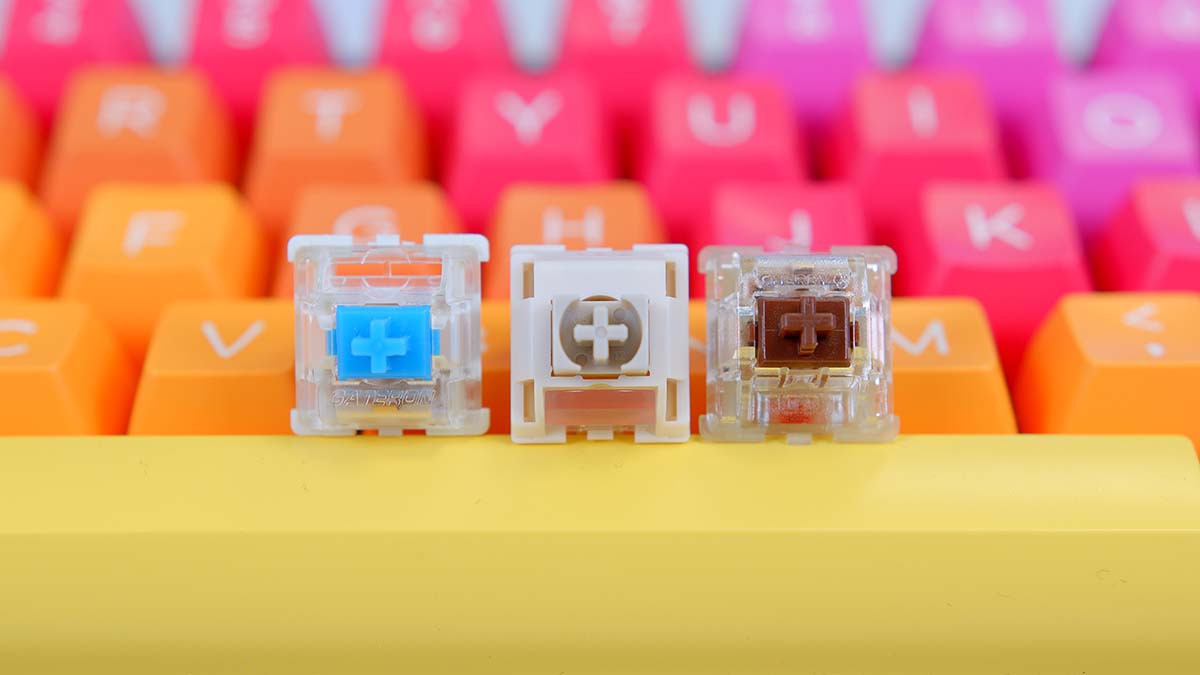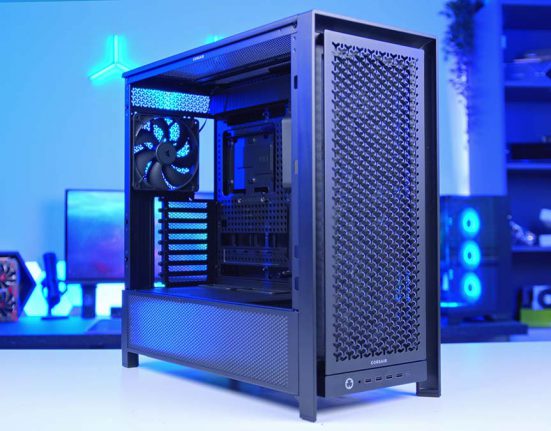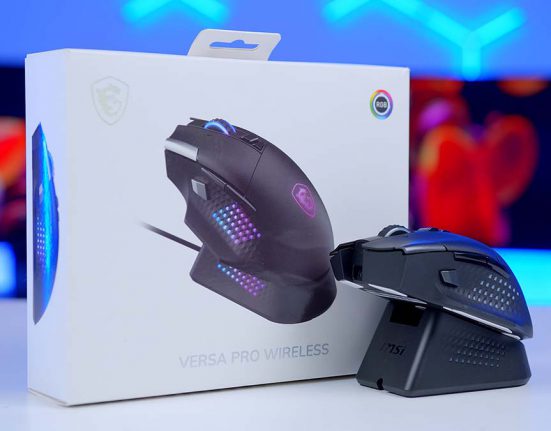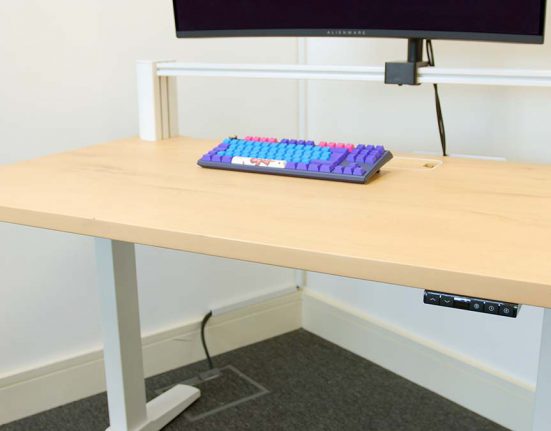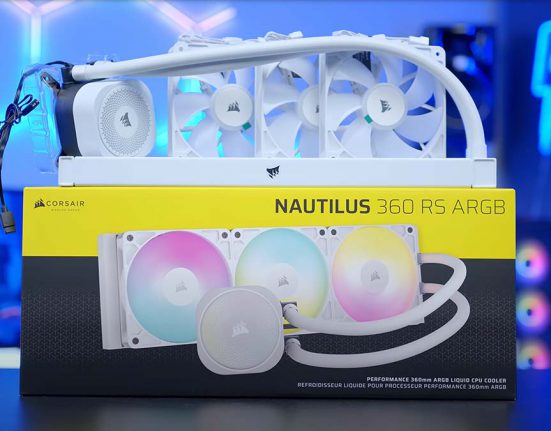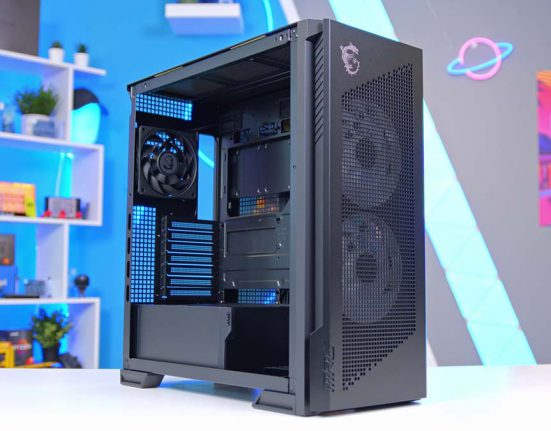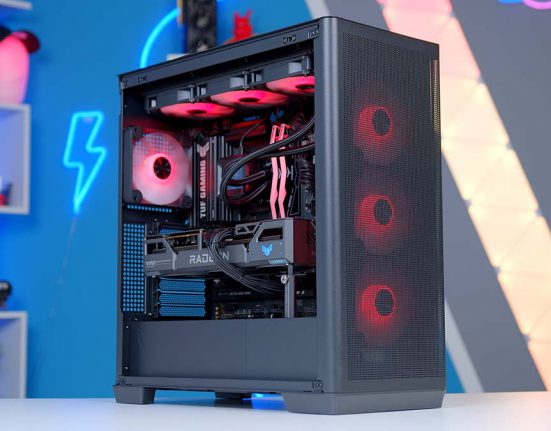Mechanical keyboard switches come in three types: Clicky, Tactile and Linear. The sound and feel can massively change depending on the mechanical switches used in a keyboard.
Mechanical switches are the principal feature of any mechanical gaming keyboard. These unique devices are the main contributors to your experience during typing and gaming. And because mechanical keyboard switches are incredibly nuanced in their designs, this has resulted in a market filled with many options. But which mechanical keyboard switch is the best?
In this guide, we’ll cover everything you need to know about mechanical keyboard switches, discussing the differences between the vast choice of switches from an ever-growing range of manufacturers. Our series of knowledge hub articles seeks to provide all the answers for PC building and gaming, whether upgrading or starting from scratch.
What Are Mechanical Switches?
A mechanical switch is a piece of hardware that sits underneath the keycaps of your keyboard. When you push down a mechanical switch, your finger pushes a low-friction stem resisted by a spring. The main point to focus on is the resistance and feel each mechanical switch provides here.
Mechanical keyboards have been around for a while. Options like the IBM Model F and Model M brought mechanical switches into the limelight in the 70s and 80s. These keyboards used a ‘buckling spring’ switch. These nostalgic and shrill designs contained a spring that ‘buckled’ when pressed.
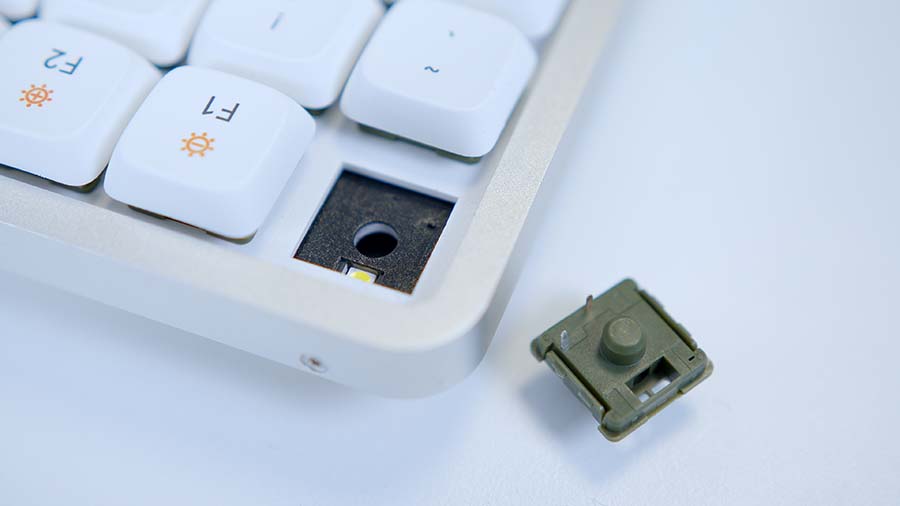
The vast majority of mechanical switches are all constructed similarly, but the resistance between them will differ, resulting in a different feel when you type and play games. Mechanical switches are made up of five parts, these are:
- Top Housing—This half holds your mechanical switch together and, depending on the materials used, contributes to its sound and resistance.
- Stem – The internal pole of the switch moves down a shaft, actuating a keypress while producing some form of feedback.
- Leaves – Two leaves sit inside your switch and connect once your stem is pressed far enough, completing a circuit and actuating a keypress.
- Spring – The spring provides the physical resistance of your switch and will entirely differ depending on the switches your keyboard uses.
- Bottom Housing – This is the lower half of the switch that holds the entire mechanism together and holds the click or tactile jacket. The pins on the bottom also connect to your keyboard’s PCB.
Why is Choosing the Right Switch Important?
Choosing the right mechanical switch is vital for a few reasons. The main ones are feel, sound, and responsiveness. These factors are entirely preferential, but they are still important nonetheless.
The feel and sound of a mechanical switch go hand in hand. You could be looking for a creamy and silent keyboard with switches that offer minimal resistance or even instant feedback with high noise levels. However, because there are so many different types of switches on the market that provide a different feel, choosing the correct set of switches is vital.

Responsiveness determines how much force you must apply, which then actuates the switch. The resistance of the spring inside a mechanical switch changes depending on the switch you’ve chosen.
This is particularly important for both typing and gaming. Gaming requires speed and high responsiveness, so a switch with minimal resistance is essential. On the other hand, many typists prefer more resistance, as using more than just a couple of fingers makes this a preferential characteristic.
Mechanical Switch Types
Clicky Switches
The most well-known type of switch is called ‘Clicky’ because of the sound they make when pressed, which is a click. These switches are amongst the most popular options on the market and have a long history.
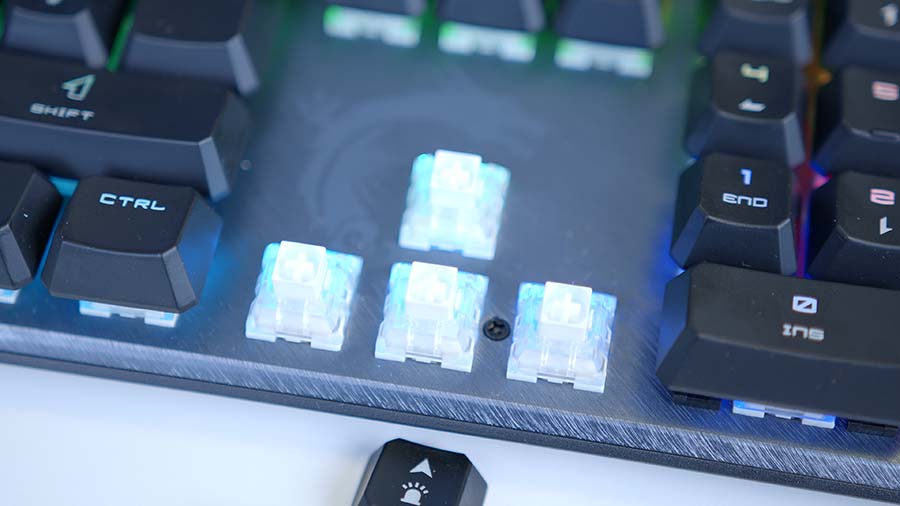
As a general rule of thumb, Clicky switches tend to have more resistance than Linear and Tactile switches because they don’t actuate until you hear a clicking sound. For this reason, Clicky switches are generally more prevalent among typists than gamers, as responsiveness is critical during an intense game.
Tactile Switches
Tactile switches are similar in responsiveness to Clicky switches but provide a quieter ‘bump’ instead of an audible click sound. For this reason, Tactile switches offer an excellent middle ground for those who want the physical feedback response but aren’t big fans of the noise that comes with Clicky switches.
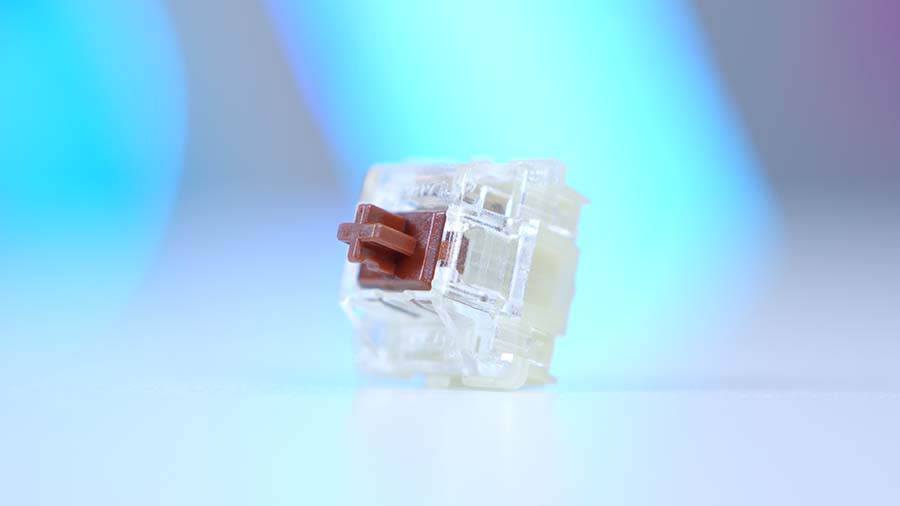
It is relatively easy to denote whether your switch is Tactile based on its colour. Tactile switches are generally represented by brown, but other brands use alternative colours. Regarding specs, Tactile switches offer less resistance than most Clicky switches and provide less travel.
Linear Switches
Linear switches are the smoothest of the three types, providing no physical feedback as the switch bottoms out. These switches are ideal for those who prefer minimal noise from their keyboard. Linear switches are incredibly popular and generally geared more towards gamers, as you can rapidly press the switch with little resistance.

Linear switches come in many colours and shapes but are typically denoted by red. The main goal of a linear switch is to maximise smoothness, which is why you’ll find so many different options on the market that are finely tuned to provide smooth actuation but require different levels of force.
Switch Specs Explained
Each mechanical keyboard switch has a set of specs which determine the responsiveness, feel, and force required for the keypress to actuate. We’ve briefly explained these specs and what they affect below:
- Operating Force: This is the physical force required for the switch to actuate and for your desktop or laptop keyboard to respond. This is measured in centinewtons (cN) but is also denoted as ‘gf’ (which is gram force).
- Travel: Travel refers to the switch’s stem moving down the shaft as you press a key. This is measured in millimetres.
- Actuation Distance: The actuation distance is how far the stem of your mechanical switch has to go down before it activates. This is also known as ‘pre-travel’.
- Total Travel: The total travel of your mechanical switch is the entire distance the stem will travel before it hits the bottom of the switch. This is referred to as ‘bottoming out’.
Available Switches
There is a massive range of switch types to choose from. Each offers a different take on the switch type, price point, and unique feel.
CherryMX Switches
CherryMX Switches are the foundational designs on which most modern switches are built. CherryMX revolutionised the market with more affordable parts and a simplistic switch design, making building a mechanical keyboard much more straightforward. They are among the most popular brands, offering reliable premium switches catering to many buyers.
| Switch Name | Switch Type | Operating Force | Actuation Distance | Total Travel |
|---|---|---|---|---|
| MX Blue | Clicky | 60cN | 2.2mm | 4m |
| MX Brown | Tactile | 55cN | 2mm | 4mm |
| MX Red | Linear | 45cN | 2mm | 4mm |
| MX Black | Linear | 60cN | 2mm | 4mm |
| MX Speed Silver | Linear | 45cN | 1.2mm | 3.6mm |
| MX Silent Red | Linear | 45cN | 1.9mm | 3.7mm |
| MX Silent Black | Linear | 60cN | 1.9mm | 3.7mm |
| MX Low-Profile Red | Linear | 45cN | 1.2mm | 3.2mm |
| MX Low-Profile Speed | Linear | 45cN | 1mm | 3.2mm |
| MX Green | Tactile | 80cN | 2.2mm | 4mm |
| MX Grey | Tactile | 80cN | 2mm | 4mm |
CherryMX Blue, Browns, and Reds are the main switches that are most popular among gamers and typists. Clicky and Tactile are generally geared towards everyday users and typists, while Reds are perfect for gaming.
Alternative colours like Black, Green, and Grey offer a different feeling while minimising errors due to a higher operating force. The low-profile designs are specifically designed for small form factor keyboards. MX Speed switches have a lesser actuation distance, enabling fast key presses, which again is ideal for competitive gaming.
Kailh Switches
Kailh switches are a popular Cherry alternative. These designs have surged in popularity, with Kailh becoming a go-to option for many buyers and enthusiasts. Many Kailh switches are closely aligned with the CherryMX options, with similar naming schemes and colours.
| Switch Name | Switch Type | Operating Force | Actuation Distance | Total Travel |
|---|---|---|---|---|
| Kailh Red | Linear | 49cN | 1.9mm | 4mm |
| Kailh Blue | Clicky | 58cN | 1.9mm | 4mm |
| Kailh Brown | Tactile | 58cN | 1.9mm | 4mm |
| Kailh Box Red | Linear | 44cN | 1.8mm | 3.6mm |
| Kailh Box Brown | Tactile | 44cN | 1.8mm | 3.6mm |
| Kailh Box White | Clicky | 44cN | 1.8mm | 3.6mm |
| Kailh Speed Silver | Linear | 39cN | 1.1mm | 3.5mm |
| Kailh Speed Bronze | Clicky | 49cN | 1.1mm | 3.5mm |
| Kailh Speed Gold | Tactile | 49cN | 1.4mm | 3.5mm |
| Kailh Box Jade | Clicky | 49cN | 1.8mm | 3.6mm |
| Kailh Canary | Tactile | 41cN | 2mm | 4mm |
Kailh popularised the ‘Box’ variants, which are used in various OEM keyboards. You can easily distinguish a Box switch from a regular one by looking at the walled stem. This design approach provides extra stability, minimising any keycap wobble. Box switches are also protected from dust and moisture, reducing the possibility of dust clogging up the switch shaft and creating extra friction.
While Kailh switches work similarly to CherryMX, their designs are more refined regarding actuation force, feel, and materials used. Kailh mechanical switches are generally more affordable, so you’ll see them used in various budget-oriented keyboards. However, they offer a myriad of switches, all of which cater to a vast set of use cases.
Gateron Switches
Gateron is a major manufacturer in China that offers a range of Cherry alternatives. The main selling point of Gateron switches is smoothness. Out of the box, Gateron switches offer minimal friction, providing smooth travel regardless of the switch type.
Due to their smoothness, keyboards with Gateron switches are very popular among typists and enthusiasts. They are commonly found in high-end keyboards on the market.
| Switch Name | Switch Type | Operating Force | Actuation Distance | Total Travel |
|---|---|---|---|---|
| G Pro Red | Linear | 44cN | 2mm | 4mm |
| G Pro Blue | Clicky | 58cN | 2.3mm | 4mm |
| G Pro Brown | Tactile | 53cN | 2mm | 4mm |
| G Pro Yellow | Linear | 49cN | 2mm | 4mm |
| Zealio V2 | Tactile | 60cN | 4mm | 4mm |
| Oil King | Linear | 53cN | 2mm | 4mm |
| Ink V2 | Linear | 58cN | 2mm | 4mm |
| Alpaca | Linear | 60cN | 2mm | 4mm |
| Milky Yellow KS-3X1 Pro | Linear | 49cN | 2mm | 4mm |
| Baby Kangaroo 2.0 | Tactile | 57cN | 2mm | 3.4mm |
Like Kailh, there are many Gateron switches available on the market. Still, Gateron specialises in Linear options, with their Oil King, Zealio, and Alpaca sets at the top of many wishlists.
Corsair, ASUS & Other Switches
Alongside these key manufacturers, several other brands offer their own switches, including Corsair, ASUS, Logitech, Razer, and others. Most of these brands provide the three main switch types, adhering to the standardised Clicky, Tactile, and Linear options.
| Switch Name | Switch Type | Operating Force | Actuation Distance | Total Travel |
|---|---|---|---|---|
| Romer-G GX Blue | Clicky | 49cN | 2mm | 4mm |
| Romer-G GX Brown | Tactile | 49cN | 1.9mm | 4mm |
| Romer-G GX Red | Linear | 49cN | 1.9mm | 4mm |
| GL Low-Profile Brown | Tactile | 49cN | 1.5mm | 2.7mm |
| GL Low-Profile Red | Linear | 49cN | 1.5mm | 2.7mm |
| GL Low-Profile White | Clicky | 49cN | 1.5mm | 2.7mm |
| Razer Green | Clicky | 49cN | 1.9mm | 4mm |
| Razer Yellow | Linear | 44cN | 1.2mm | 3.5mm |
| Razer Orange | Tactile | 49cN | 2mm | 3.5mm |
| ASUS NX Snow | Linear | 44cN | 1.8mm | 3.6mm |
| ASUS NX Storm | Clicky | 63cN | 1.8mm | 3.6mm |
| ASUS NX Red | Linear | 44cN | 1.8mm | 4mm |
| ASUS NX Blue | Clicky | 63cN | 2.3mm | 4mm |
| ASUS NX Brown | Tactile | 56cN | 2mm | 4mm |
| ASUS RX Red | Linear | 53cN | 1.5mm | 4mm |
| ASUS RX Blue | Clicky | 63cN | 1.5mm | 4mm |
| Corsair OPX | Linear | 44cN | 1mm | 3.2mm |
| Corsair MGX | Linear | 44cN | 0.4mm – 3.6mm | 4mm |
| Corsair MLX | Linear | 44cN | 1.9mm | 4mm |
While some of these switches will offer slightly different profiles that change the actuation force, sound, and feel, they have some similarities. Corsair and ASUS, in particular, stand out from the competition due to the innovative nature of their newer switches.
Due to their magnetic design, Corsair’s MGX magnetic Linear switches have a customisable actuation force. Alternatively, ASUS’ optical RX switches are incredibly smooth and offer a walled stem that minimises wobble.


